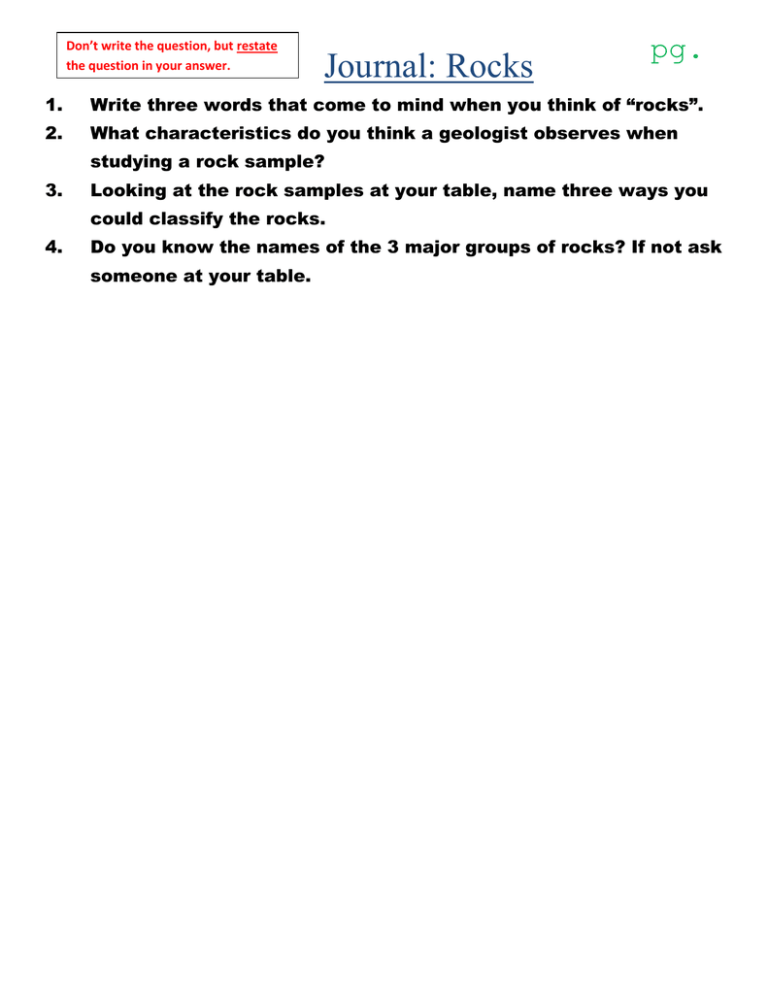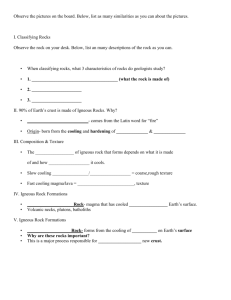Intrusive Igneous Rocks - Riverdale Middle School
advertisement

1. pg. Journal: Rocks 86 Write three words that come to mind when you think of “rocks”. 2. What characteristics do you think a geologist observes when Don’t write the question, but restate the question in your answer. studying a rock sample? 3. Looking at the rock samples at your table, name three ways you could classify the rocks. 4. Do you know the names of the 3 major groups of rocks? If not ask someone at your table. Rock Notes pg. 87 Classification of Rocks: 1. Rocks are mixtures of minerals, volcanic glass, or other materials. 2. When studying rocks geologists observe a rock’s color and texture and determine its mineral composition. a. Texture is the look and feel of a rock’s surface 1.) If the grains are easy to see it is identified as coarse-grained 2.) If the grains are too small to see if is identified as fine-grained b. Mineral composition – scientists study this by taking a small sliver of rock and looking at it under a microscope to identify the crystal structure Igneous Rock Notes How Igneous Rocks Form: 1. Igneous rocks form from the cooling of molten rock (either magma or lava) a. The name igneous comes from the Latin word ignis, meaning “fire”. b. Magma is molten rock that is below the surface c. Lava is molten rock that reaches the surface How they are classified: 2. Igneous rocks are classified according to their origin, texture, and mineral composition. 3. Origin a. Intrusive Igneous Rocks – form from magma that hardens below the surface b. Extrusive Igneous Rocks – form from lava that has erupted to Earth’s surface 4. Texture a. Intrusive Igneous Rocks – form large crystals and are coarse grained because the magma cools slowly b. Extrusive Igneous Rocks – form small crystals, are fine grained, even glassy; because the lava cools quickly c. Porphyritic – Intrusive rocks that have large crystals scattered on a background of smaller crystals. This shows the magma cooled in two stages. First slow then rapidly. d. Volcanic Glass – rocks that cool so quickly that few crystals form 5. Mineral Composition a. Basaltic igneous rocks are dark colored and dense 1.) contain iron and magnesium but very little silica 2.) basaltic lava flows freely from a volcano b. Granitic igneous rocks are lower in density and lighter in color 1.) contain more silica and less iron and magnesium 2.) granitic magma is thick and stiff c. Andesitic rocks have a more balanced composition of minerals and density than basaltic or granitic rocks Rock Notes pg. 87 Classification of Rocks: 1. Rocks are mixtures of ______________, ___________________, or _____________________. 2. When studying rocks geologists observe a rock’s _______________ and _______________ and determine its _____________________________. a. Texture is the look and feel of a rock’s surface 1.) If the grains are __________________ it is identified as ____________________ 2.) If the grains are ____________________ it is identified as __________________ b. Mineral composition – scientists study this by taking a small sliver of rock and looking at it under a microscope to ____________________________________________ Igneous Rock Notes How Igneous Rocks Form: 1. Igneous rocks ______________________________________________ (either magma or lava) a. The name igneous comes from the Latin word ignis, meaning “_____________”. b. Magma is molten rock that is _______________________________ c. Lava is molten rock that ______________________________ How they are classified: 2. Igneous rocks are classified according to their origin, texture, and mineral composition. 3. Origin a. Intrusive Igneous Rocks – form from ___________ that hardens __________________ b. Extrusive Igneous Rocks – form from _________ that has erupted to _______________ 4. Texture a. Intrusive Igneous Rocks – form ____________________ and are __________________ because the magma __________________________ b. Extrusive Igneous Rocks – form ___________________, are _____________________, even glassy; because the lava _________________________ c. Porphyritic – Intrusive rocks that have large crystals scattered on a background of smaller crystals. This shows the _________________________. First slow then rapidly. d. Volcanic Glass – rocks that cool so quickly that ___________________________ 5. Mineral Composition a. Basaltic igneous rocks are ______________________________________________ 1.) contain iron and magnesium but very little silica 2.) basaltic lava flows freely from a volcano b. Granitic igneous rocks are _____________________________________________ 1.) contain more silica and less iron and magnesium 2.) granitic magma is thick and stiff c. Andesitic rocks have a more _____________________________ of minerals and density than basaltic or granitic rocks Size of Crystals Colors (none, small, medium, large) IGNEOUS ROCK ID Basaltic Texture Intrusive - dark colored /dense (fine-grained or coarse-grained) Granitic -light colored/low density Andesitic -balanced/blended composition - large crystals/coarse grained Extrusive - small or medium crystals/fine grained A B C D E F G Review Questions: 1. How are igneous rocks formed? 2. What is the difference between intrusive and extrusive? 3. What is the difference between basaltic, granitic, and andesitic? Conclusion Questions: 1. Infer which rock samples are granitic based on color. 2. Infer which rocks cooled quickly. What observations led you to this inference? 3. Identify any samples that suggest gases were escaping from them as they cooled. 4. Which samples have a glassy appearance? How did these rocks form? ROCK NAME pg. 73 Sedimentary Rock Notes Form from particles deposited by water and wind. They often form as layers. How Sedimentary Rocks Form: 1. Sediments are eroded and moved by wind, water, ice, or gravity. 2. Then they are deposited – settled out of the water, wind, or ice carrying it. 3. Compaction – occurs over time. The layers can become very thick. The thicker the layers the more they press down. 4. Cementation – occurs during compaction. The dissolved minerals in the rock seep deep into holes and crystallize acting like a glue How they are classified: 1. Detrital or Clastic o Sedimentary rocks are made from broken pieces of other rocks. o They have a granular texture. o Named according to size and shape of sediments a. sediment size can be large like gravel or small like clay i.) shale is made from tiny particles of clay ii.) sandstone is formed form small piece of sand b. sediments can be well rounded or have sharp angles i.) Conglomerate and breccia rocks are made from various size sediment fragments 2. Organic rocks Rocks that form from the remains of plants and animals which are deposited in thick layers a. coal forms from the remains of swamp plants buried in water b. chalk forms form the hard shells of living things 3. Chemical rocks Form when minerals that are dissolved in a solution crystallize a. can also form when mineral deposits are left when seas or lakes evaporate. Sedimentary Rock ID Observations Fossils Present Sediment A B C D Detrital, Chemical, or Organic ROCK NAME Metamorphic Rock Notes The most important thing to remember is that these rocks are formed by the processes of HEAT AND PRESSURE! How Metamorphic Rocks Form: o Heat and pressure result from one layer of rock on top of another layer 1.) sometimes temperature and pressure are great enough to melt rock, forming magma 2.) sometimes pressure flattens mineral grains in rocks without melting them o Every metamorphic rock is a rock that has changed its form – its appearance, texture, crystal structure, and mineral content change o Metamorphic comes from the Greek words 1.) meta meaning change 2.) morphos meaning form How they are classified: o Metamorphic rocks are classified by composition and texture 1. Foliated rocks – rocks that have their grains arranged in parallel layers or bands, rocks can split along these layers 2. Non-foliated – rocks whose grains are randomly arranged, do not split into layers Drawing E F G H Metamorphic Rock ID Description Foliated or Nonfoliated ROCK NAME








